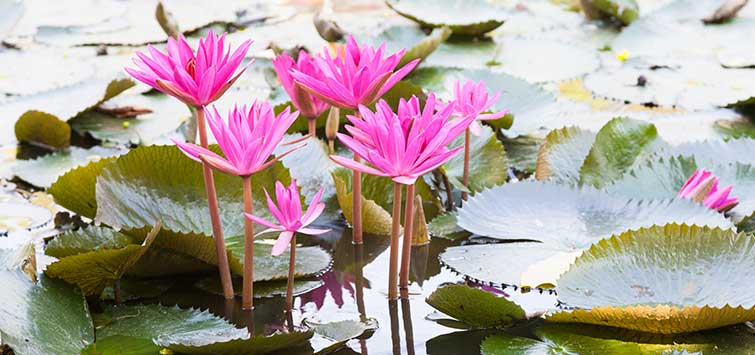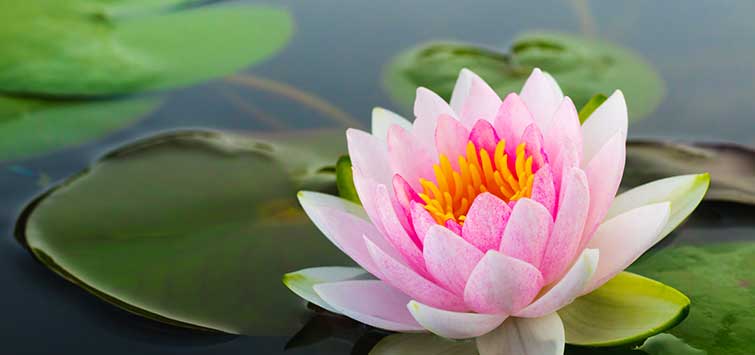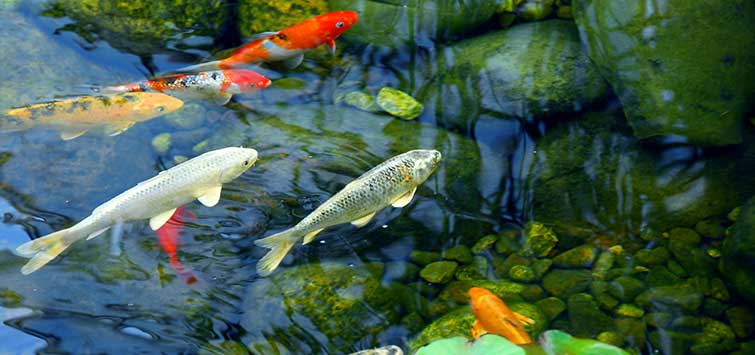Lotus for Your Koi Pond
Author: Larry Nau
Pond plants can be challenging to keep with koi, but lotus are attractive plants that will compliment your koi pond perfectly—without ending up on the fish’s menu!
Maintaining Pond Plants with Koi
A koi pond represents one of the many pinnacles of the aquarium hobby. Koi are massive fish complete with spectacular colors and outstanding personalities. What hobbyist would not want a 10,000 gallon pond in their backyard filled with these magnificent fish? However, with their size—commonly over 30 inches—comes a voracious appetite. Koi are always searching for food whether it is supplied by you or found naturally in a pond.
Usually pond plants are a challenge to keep with koi, as they top these ever-hungry fish’s menu. Soft submerged plants, such as anacharis, are eagerly consumed. Floating plants such as water hyacinth have their roots torn off and are seen bobbing like a beach ball across the water’s surface. Waterlilies are also not spared. Commonly koi will consume the floating leaves, but other times they will eat the flower itself. A pot filled with soil provides a spot to forage in the mud to search for food or just to pass the time of day. The end result is a floating waterlily and extremely muddy, murky water!
So is there a plant that may be kept with koi? I would like to suggest the answer is yes, and that plant is the lotus.
What Is Lotus?
First, lotus are viewed as Asian plants (although there is a North American species as well), and since koi are Japanese fish, the two compliment each other well in a pondscape with an Asian theme. Second, lotus are grown in shallow water; it is best to only have an inch or two of water covering the top of the pot. With so little water, koi can not get in to dig in the pot.
Next, lotus stems are covered with short, rigid spines. These provide a good form of defense against a hungry koi. Lotus grow up and out of the water after the first few surface leaves. Aerial leaves and flowers may held as high as six feet above the water’s surface, well away from the menacing koi. The lotus leaves also can provide beneficial shade for koi. Finally, lotus may also be grown in a container next to pond, safely away from the koi yet providing a flash of green to soften the pondscape.
How Lotus Works
Lotus varieties number over 800 around the world, but only about 30 cultivars are commonly found in the United States. Lotus may be small, growing only 2 feet high, but there’s a large variety that grows up to 6 feet high with flowers that are up to 12 inches across!
Flowers may be single or double in relation to overall petal count. The spectrum of flower colors range from yellow to white, and from red to pink. Lotus leaves are fascinating, as they are covered with micro hairs. This causes water droplets to bead up on the leaf’s surface like mercury. The morning dew or a light summer’s rain is delight to watch as it rolls on a lotus leaf. Finally, at the end of the flower’s life, it forms a lotus seed pod. These pods are prized by florists in their flower bouquets.
How to Plant Lotus
1. Lotus are frequently purchased as established, potted plants from most water garden retailers. Once home, a bit of gravel on the pot’s surface and the lotus is ready to rest in the water. Keep it shallow, as mentioned earlier, as lotus love warm water and a maximum exposure to the sun’s light.
2. Often it is necessary to purchase a lotus tuber for easy transport or to acquire a specific variety. It is best to plant this tuber in a pot that is approximately 23 inches across and only 10 inches deep. The will give the plant plenty of room to grow for several seasons.
3. Fill the pot halfway with a mix of commercial aquatic potting soil and topsoil. Lay the tuber in so the cut end is against the wall. The growing tip on the opposite end should be in the center and slightly angled to the surface. Carefully fill the rest of the pot with the soil mix and press down the soil to eliminate air pockets. Be very careful with the growing tip of the lotus tuber; if this tip is damaged or snapped off it could kill the tuber.
4. Fill the pot with water and leave out in a sunny warm spot for several weeks. Once new growth is present on your lotus, use up to three pellets of aquatic fertilizer every two to three weeks in the pot. Fertilizing your lotus is essential for maximum growth and flower production. Here in the Northeast, we usually fertilize regularly from May until the end of August.
Maintaining Lotus
Established lotus require minimum care. Remove dead leaves only after they are totally brown. Cutting a green leaf below the water line may result in water flowing down the stem into the tuber and killing your plant.
The most common pest is the aphid. These sap-sucking insects are most common during the heat of the summer. It is best just to rinse them off with your garden hose and let your fish feast on them. There are several organic aphid sprays available that are totally safe and effective.
Once the cold temperatures have killed off the leaves for the season and the stems are brown, cut back this dead growth. Drop your lotus to a depth of at least 2 feet for its winter dormancy. If a lotus tuber freezes, it will die.
There’s A Lotus for Every Taste
Selecting lotus for your koi pond is always a challenge, as they are all so beautiful. If you are looking for a small variety I would suggest Nelumbo sp. “Momo Boton.” N. sp. Momo Boton grows to about 2 feet tall and has a double, rich rosy pink flower. For larger lotus, N. “The President” is a single dark red with flowers up to 12 inches across. Another excellent choice is N. sp. “Mrs. Perry D. Slocum,” which is a large double flower and is changeable. On the first day the flower opens yellow, and by the third day the blossom has transformed to a creamy pink flower with 86 petals!
More lotus are entering the market every year. Professor Guozhen Huang, from the People’s Republic of China, has introduced a number of spectacular lotus in recent years. A personal favorite is N. sp.“Laoshan Redsun,” which is a medium-growing, double, red lotus.
Lotus are an excellent selection for introducing lush green foliage crowned with spectacular flowers to your koi pond. They add a sense of awe and enchantment to your pondscape. Try some this season—and have plenty of pelleted food on hand for your swarming, frustrated koi!

.png?h=595&iar=0&w=2781&hash=5FD5E69473BCC22199FBFA2FB71B6033)



